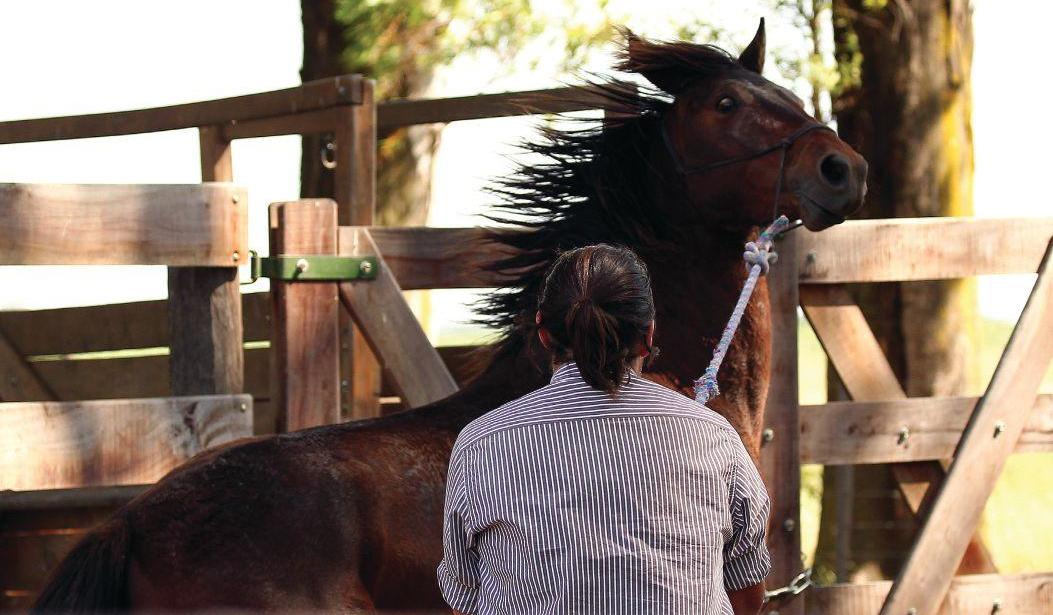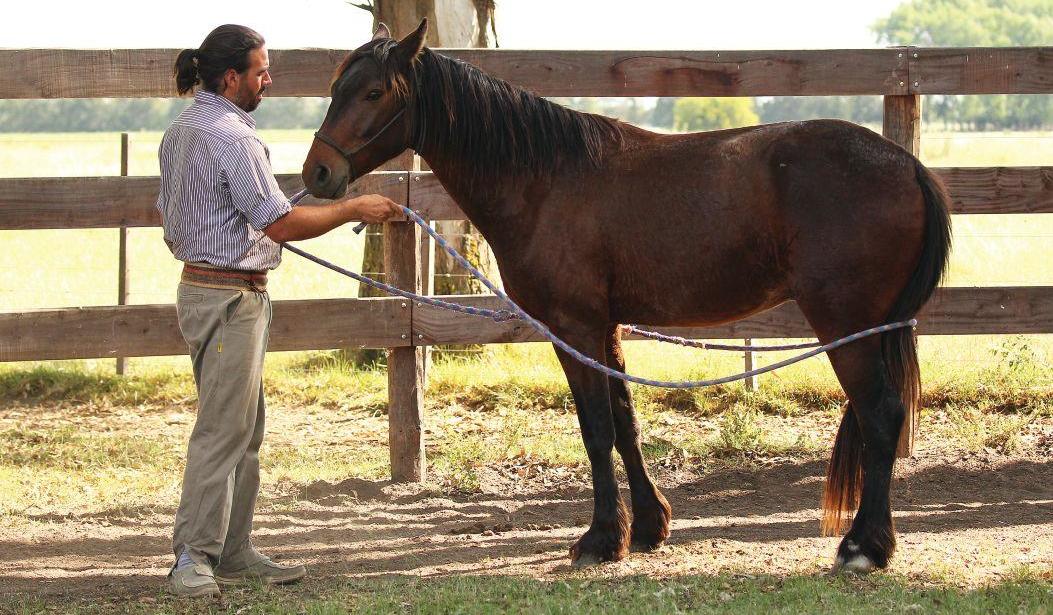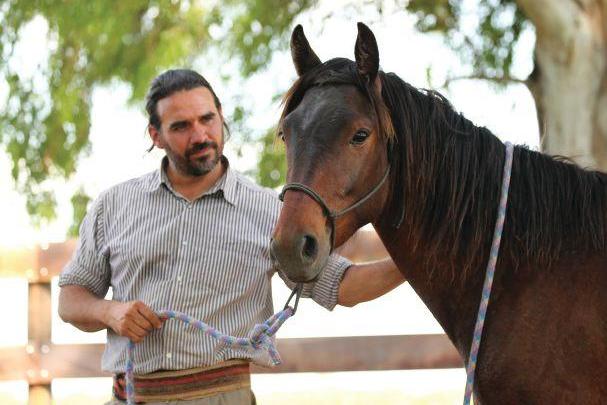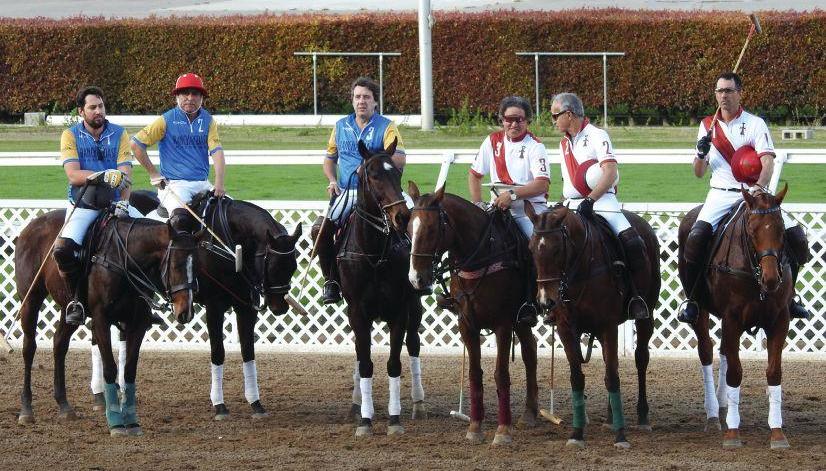
14 minute read
Equine Athlete
Peaceful approach
Horse training methods derived from Ranquel indians
Words and photos by Alice Gipps
Top, left: Cristobal hangs out with La Coqueta, who he trained; Top, right: Oscar, Gonzalo Pieres Sr. and Cristobal; Bottom, right: Nico Pieres on La Coqueta in the Argentine Open; Bottom, left: Oscar and Cristobal with an Ellerstina polo pony.
THE SCARPATIS are a family of horse tamers from Argentina. Seeing them work will change your view about training wild horses. They make something that is believed to be difficult and dangerous so simple. Their method works with horses of any age, even traumatized and difficult ones.
Patriarch Oscar Scarpati’s connection with horses started as a child. One of 11 children, he was very
withdrawn and exhibited unusual behavior from an early age. He was subsequently diagnosed with autism at the age of 12. He didn’t speak a word for many years, however, his mother realized he was always happy and relaxed around horses so she would often leave him to watch them.
Although his mother had always taught him to be sensitive and kind towards animals, a big influence in



his life has been an elderly gentleman called Don Cristobal Luna. He was like a grandfather and helped Oscar to come out of his shell and interact with the world around him. Luna taught him empathy towards all living animals, to understand horses have fears and how to gradually gain their trust by playing with them. Luna was 88 years old when Oscar met him, so he never had the chance to see him training horses but he spent hours listening to his stories and methods.
Step by step over the years, Oscar became an expert in horse psychology. Guided by Luna’s teachings he delved into the Ranquel Indian’s culture. The Ranquel were an indigenous tribe from the northern part of La Pampa Province, Argentina, in South America. Some Ranquel settled in the province of San Luis where the Scarpati’s have their family farm. Today the Scarpatis use the term ‘Doma India’ to define their methods, which use very alternative techniques to the traditional Argentine ways.
Oscar learned extraordinary subtle ancient techniques to train horses, using no violence, only patience, good intentions, thoughts and a deep understanding of the horses’ instincts and body language for communication. Accumulating wisdom, transmitted from generation to generation through words, deeds and example, it has turned in to his family’s philosophy for life. It combines character, personality and emotions when dealing with any living creatures around us

with the intent that love and understanding leads to happiness and harmony. He has used his knowledge to also connect with wild pumas and condors.
Oscar explains, “We can forget the animal has valid feelings too and didn’t choose to be trained. The way a trainer achieves behavior change matters, especially if we put ourselves in the animal’s place. We now know animals experience emotion much the same as humans do. We are wholly responsible for the emotions we elicit in our horses through training. To me, a trainer’s oath should be the same as a physician: First, do no harm: physically or emotionally.”
His son Cristobal has followed in his footsteps and together they perform fascinating demonstrations that are just as much about philosophy as they are horse training.
“I grew up helping my father training horses. It’s something that just happened as I grew up. He didn’t train me, I just witnessed his job. As I grew up I discovered I had something special from him,” explains Cristobal. “When I was a teenager I thought I should do something else, so I studied law at college, but I discovered that horses are the only thing that makes me really happy in life.
“When I was a kid I wanted to be rich as I watched movies, but I found that in Argentina no horse trainer was rich at that time. I was trying to be a lawyer, but later, I understood it is much more valuable to be hapCristobal imitates how horses interact with each other in his training. It makes the horse more open to learn.
Top: An unbroke horse at the start of a clinic tries to flee rather than be touched. Above: Cristobal says the first step is to bring the horse’s attention to you.


py. When I took the way of the horses, not everything was easy. It has been hard to make the name, to make enough prestige to live from this activity, but it was easier to be happy. The whole family is involved so we are sharing so much, we travel a lot together. We’re sharing our method to train horses, we’re sharing our life,” he said.
When working with untouched horses, the Scarpatis work very fast. If the horse is young and not traumatized, they are usually riding it in the first day. “We do not recommend that for beginners, those who are learning or really professional as it’s not necessary, it’s very
risky,” said Cristobal. “Normally we only do it that fast as we are performing a demo or showing someone how to do it. We always recommend taking your time and giving the horse longer to learn.”
When doing ground work, they separate training and taming. “To start we are creating the bond as the horse is scared of people, very sensitive and ticklish to being touched.” Cristobal said. “The first step is to bring their attention to us, show them we won’t make anything bad against them. Later we touch everywhere with our hands and feet to get them accustomed to our contact.”
The goals of their method are to get closer, make contact, touch all over and make some moves.
“This may take one hour, one day, two days; it doesn’t matter but normally a person needs two hours to get close and one hour to touch everywhere. In three to four hours I can mount it,” Cristobal said.
“I am a teacher and always thinking from the student’s point of view. It doesn’t matter how much time [it takes]. Be careful, go by your emotions and learn more about yourself than about the horse. You can see it being nervous or relaxed. You can’t be confused about how you feel,” he explained. “If you are nervous, there is a 95% chance you make the horse nervous or scared. Our mission is to help people train themselves. After that, you can train a horse, a dog and other animals. In the game we play, the physical contact is very impor
tant. We try to imitate how horses interact with each other. You will see two colts playing, they bite the knees, the flank and the neck. We have to be in good shape to work young horses.
“Dominance is part of our job but the intention we have when we practice this is the way that they use dominance in their hierarchy. They have their own organization and when you come into their lives and act as a higher horse, they will accept and understand more of what you are trying to do. If instead, you take the role with a whip and start to give orders, push, kick or hit, they then become victims in a reality that they cannot understand. When you act as a horse, they are more open to learn and in our experience, they learn very fast.”
Cristobal started working with polo ponies 12 years ago for Ellerstina after approaching Gonzalo Pieres and convincing him to try a new method for starting their young horses . The Scarpatis wanted to show there was a quieter way to train the horses and many domadors are now following their lead. One of Nico Pieres’ best mares, Open Coqueta, which he plays in the Argentine Open, was started by the Scarpatis. Cristobal says that although they love to work on polo horses for a big organization, doing it full time is too time consuming.
Their calling in life is to educate others, spread their knowledge and show as many people as they can how to make a difference by traveling and performing courses

and demonstrations. This way they can reach far more people and ultimately help many more horses enjoy the benefits of their work.
Watching Oscar and Cristobal work with an untamed horse is something magical, an unforgettable experience, which will fill you with many emotions. Even people attending a demonstration who know very little about horse training leave in awe and wonder at how simple it can be. You are also filled with happiness that such a worried soul can make friends with its

Cristobal stays relaxed and shows the horse he will not harm him. Eventually, the horse allows him to get closer and touch him.
Players enjoy playing on the beach in Newport in late February.
NEWS • NOTES • TRENDS • QUOTESNEWS • NOTES • TRENDS • QUOTES
HEAD Subhead FOOD FOR GOOD Beach crowd buoys MLK Center
ARECORD beach crowd contributed 1,165 pounds of food and $268 in cash donations for the Dr. Martin Luther King Jr. Community Center in Newport, Rhode Island, Feb. 25. The generous crowd was attending the 9th annual Beach Polo exhibition for the closing weekend of the 32nd Newport Winter Festival.
The lively two-day event pitted teams from the Newport Polo Club in four-chukker polo matches during low tide on Sachuest Beach (locally known as 2nd Beach) free of charge for over 1,000 viewers each day. Spectators responded to the call for donations with non-perishable dry-goods, toiletries and household items collected by MLK Center volunteers at the Beach Pavillion.
“Newport Polo has maintained a focus on benefitting the community since its beginning in 1992,” said Newport Polo founder and president, Dan Keating. “We are grateful to our enthusiastic audience for turning out in record numbers for Beach Polo and embracing MLK Center’s year-round hunger services, and it would not have been possible without the collaborative spirit of the Town of Middletown and Newport Winter Festival.”
Sunny and milder winter conditions helped attract the large turnout at the beach on both days, with food trucks, music and commentary adding to the ambiance, followed by hot chocolate and outdoor refreshments on the Terrace at The Chanler for the traditional après-polo celebration with the players.




JOHN LINCOURT
ON THE RAIL Polo match played at Del Mar Racetrack




TEAMS CONVERGED at the Del Mar Racetrack in Del Mar, California, on Feb. 22, to stage a 10-goal polo match right on the track, followed by a Cuban Nights-themed concert and dance party in the Paddock, featuring the band Amistad Cubana. The match, featuring teams from Mexico and the U.S., was dedicated to Guillermo “Billy” Steta, president of the Mexican Polo Association for eight years until his untimely death on Nov. 1 at the age of 56. Born in Mexico City, Billy started playing polo at the Jalapa Polo Club as a 12-year-old boy. As a passionate player and an ambassador of the Federation of International Polo, he traveled the world playing and promoting international polo in countries, including Argentina, Chile Colombia, Venezuela, India, Spain, Panama, Barbados, the U.S., Canada, England and Germany. Several of the players in the Del Mar match were Billy’s close friends and teammates. The match saw San Diego Daou Vineyards (Santiago “Topo” Mendez, Nour-Dean Anakar, Philip Ruan, Ahmed Mounkachi) narrowly edge Mexico Ranch & Coast Magazine (Miguel Gomez de Prada, German Coppel, Saul Flores, Demetrio Amaya), 12-10, in a fast, action-packed match in front of a large crowd of polo enthusiasts and social guests. After the match, guests enjoyed cocktails and dancing. Another match is planned for April, with proceeds benefitting Helen Woodward Animal Center.

TYLER SCHUTZ
TYLER SCHUTZ
The international match, played on the racetrack in California, was dedicated to Billy Steta.
POLO CAMP Coaching clinic held in India
ARURAL POLO and community-based pony preservation initiative was recently started at Kumbi, a village on the shores of Loktak Lake, the largest freshwater lake in Northeast India. Ed Armstrong, of Huntre! Equine, traveled from Massachusetts to conduct a two-day coaching camp. The event was held just prior to the 5th Manipur Statehood Day Women’s Polo Tournament in Imphal, Manipur. The clinic was made possible, thanks in part to the U.S. and Argentine teams—finalists in the 4th Manipur Statehood Day Women’s Polo Tournament–who donated their tournament prize money. In addition, a U.S. Polo Coaching Camp for Rural Youth was held on the heritage polo field in the village. Six youth, with riding but no polo experience, were selected for the camp. Drills included basic lessons in polo on two wooden horses built by the villages using instructions sent ahead of time by Armstrong.


There is something about riding down the street on a prancing horse that makes you feel like something, even when you ain’t a thing.
ONE ARM BANDIT Polo club guests enjoy unique performance
GRAND CHAMPIONS Polo Club in Wellington, Florida, had a visit from the One Arm Bandit, also known as John Payne. Payne performed a halftime show where he ran a couple of horses around his truck before they jumped onto the back of the truck and up a ramp on the nose of his trailer, until they were standing on the top of the trailer. He followed on a horse he was riding.
Payne is known for his shows around the rodeo circuit. He sometimes brings along his mule Moe, his zebra Zorro, Watusi longhorns, mustangs and even buffalo, all trained to get on top of the trailer. He performed last summer at the Aspen Valley Polo Club in Carbondale, Colorado, with the zebra and a few horses. He rode one of his horses on the roof of the stock trailer, while a friend drove it onto the middle of the polo field. He rode the horse off the trailer to chase his other horses around the polo field before he rounded them up and followed them onto the roof of his trailer. The performance was a big hit with the polo players and he wrote on this Facebook page that he was equally impressed with the polo people.
Payne threw out the ball to start the WPL Founders Cup on March 1, then performed at halftime. He has been performing on the rodeo circuit for 32 years and has been named the Professional Rodeo Cowboys Association Specialty Act of the Year 15 times, an award voted on by professional cowboys, announcers, stockmen and performers. He was also inducted into the Ellensburg Rodeo Hall of Fame in 2017. He has done up to 100 shows a year, but now at 66 years old, he tries to limit it to about 40. His adult son and daughter also perform with him sometimes.
Payne lost his arm when he was 20 after being electrocuted. He climbed a power pole to disconnect electricity to a house he was tearing down and the next thing he knew he was on the ground. He says he lost his arm and nearly his leg in the accident.
The disability doesn’t seem to have held him back one bit. Payne trains his animals, many of them extremely difficult to train. He has called buffalo the meanest critter in North America and admits they tried to kill him many times. Twice they have knocked him and his horse off the trailer roof. His mule was also difficult to train. Apparently, he wouldn’t let you catch him, bridle him, saddle him, get on him or ride him at first. Now, Payne counts on him for the most difficult tasks, like jumping off the trailer roof onto asphalt during parades and climbing the ramp when its wet. He says the mule can outwork two horses.



One Arm Bandit, John Payne, rides to the top of his trailer at Grand Champions Polo Club.










